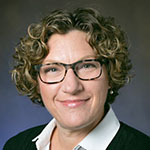American Meteorological Society Recognizes ARM/ASR Community Members in 2021
Published: 16 February 2021
Amid the virtual science talks and poster sessions, the 101st American Meteorological Society (AMS) Annual Meeting carved out time to celebrate members of the weather, water, and climate community.
Five members of the Atmospheric Radiation Measurement (ARM) user facility and Atmospheric System Research (ASR) community received recognition on the opening day of the January 2021 AMS Annual Meeting.
New AMS Fellows
AMS honored 25 fellows for their contributions to atmospheric or related oceanic and hydrologic sciences. Three of the fellows—Robert Jeffrey Trapp, Sue van den Heever, and Rob Wood—have ARM/ASR connections.
Fellows are elected annually at the AMS council’s fall meeting. No more than 0.2% of AMS members can be named fellows each year.

Trapp is a professor and head of the Department of Atmospheric Sciences at the University of Illinois at Urbana-Champaign. He was a co-principal investigator for the 2018–2019 Remote Sensing of Electrification, Lightning, and Mesoscale/Microscale Processes with Adaptive Ground Observations (RELAMPAGO) study, a project largely funded by the National Science Foundation. RELAMPAGO, which set up shop in Argentina to study the world’s most intense thunderstorms, ran concurrently with ARM’s Cloud, Aerosol, and Complex Terrain Interactions (CACTI) field campaign.
Trapp has led or co-authored papers using ARM data from CACTI and the Southern Great Plains atmospheric observatory. From 2015 to 2018, he led an ASR project on improving the representation of deep convective clouds in weather and earth system models. The project involved Southern Great Plains data from the Midlatitude Continental Convective Clouds Experiment (MC3E), a 2011 ARM-NASA campaign.
In addition to his research and teaching, Trapp recently served on the ARM Science Board, an independent board that reviews proposals for use of the ARM facility.

A professor in the Department of Atmospheric Science at Colorado State University, van den Heever is a co-investigator for the upcoming TRacking Aerosol Convection interactions ExpeRiment (TRACER) in the Houston, Texas, area. She co-led a team within the Aerosol, Cloud, Precipitation, and Climate Working Group that developed the road map for what is now TRACER.
In 2020, ASR awarded van den Heever funding for a TRACER-related project to study deep convective cloud processes, including the influence of aerosols, and evaluate how models represent these processes.
Among other ARM/ASR-related work, van den Heever was a co-investigator for CACTI. From 2013 to 2018, she led an ASR-funded project to investigate aerosol effects on thunderstorm clusters known as mesoscale convective systems during MC3E.

Wood, a professor of atmospheric sciences in the University of Washington’s College of the Environment, has been an investigator on numerous ARM campaigns. In particular, he has deep ties to ARM’s Eastern North Atlantic (ENA) atmospheric observatory.
Wood was the principal investigator for ARM’s first field campaign in the Azores—a pre-ENA campaign called Clouds, Aerosol, and Precipitation in the Marine Boundary Layer (CAP-MBL). Almost a decade later, he was a co-principal investigator for the ground- and air-based Aerosol and Cloud Experiments in the Eastern North Atlantic (ACE-ENA) campaign. In addition, he led an ASR site science team to develop research strategies for the ENA.
From 2020 to 2023, Wood is leading an ASR project using ARM data to study the role of turbulent dynamics in driving aerosol-cloud interactions over ocean and land. He is also a co-chair of ASR’s Warm Boundary Layer Processes Working Group.
AMS Awardees

Sonia Lasher-Trapp, a professor in the Department of Atmospheric Sciences at the University of Illinois at Urbana-Champaign, received the Edward N. Lorenz Teaching Excellence Award. This honor recognizes outstanding teaching, mentorship, and impact on college/university students.
AMS gave the award to Lasher-Trapp “for creating active learning and welcoming classroom environments, expanding student experiences, and advocating for women in science.” As the Lorenz winner, Lasher-Trapp gave a keynote talk during the AMS 30th Conference on Education on January 14.
Lasher-Trapp is leading a three-year ASR project combining CACTI data analyses and modeling to look at general trends of aerosol effects upon convective cold pools. She is also on the ARM Science Board.

Kerri Pratt, an associate professor of chemistry at the University of Michigan, received the Henry Houghton Award for early career research achievement. AMS cited Pratt’s “pioneering field and theoretical studies that have significantly advanced the understanding of atmospheric chemistry in the arctic boundary layer.”
Pratt has led several arctic aerosol campaigns, including studies at ARM’s Alaskan sites at Utqiaġvik (formerly Barrow) and Oliktok Point. During AMS, she gave an invited presentation on how aerosol composition in the Arctic is influenced by the North Slope of Alaska oil fields.
Currently, Pratt is analyzing the chemical composition of particles collected during a 2018 campaign at ARM’s North Slope of Alaska atmospheric observatory and the 2019–2020 Multidisciplinary Drifting Observatory for the Study of Arctic Climate (MOSAiC) expedition. The U.S. Department of Energy’s Early Career Research Program is supporting Pratt’s work.
See the full list of 2021 AMS honorees.
Nominate Your Peers for 2022 AMS Honors
The deadline to submit nominations for 2022 AMS honors is May 1, 2021. To learn more about the honors or to submit a nomination, go to the AMS Awards and Honors web page.
The 2022 AMS annual meeting is scheduled from January 23–27 in Houston.
Keep up with the Atmospheric Observer
Updates on ARM news, events, and opportunities delivered to your inbox
ARM User Profile
ARM welcomes users from all institutions and nations. A free ARM user account is needed to access ARM data.


















